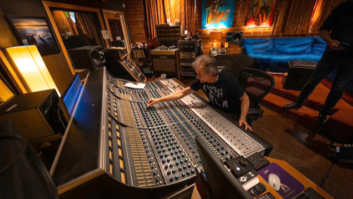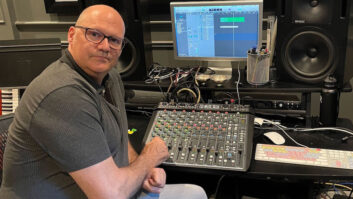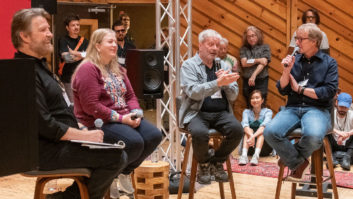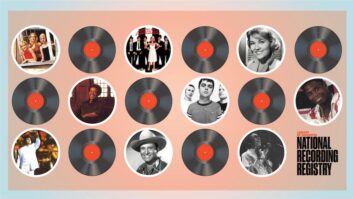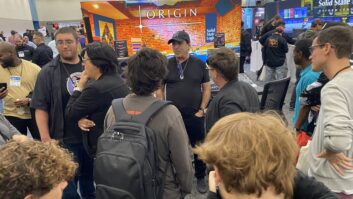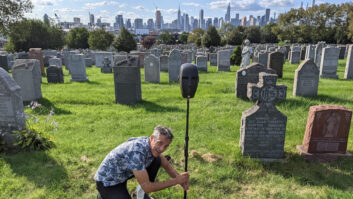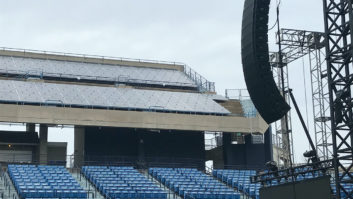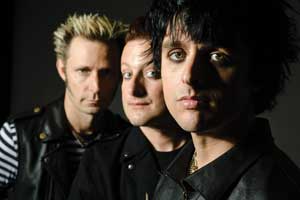
From left: Mike Dirnt, Tré Cool and Billie Joe Armstrong
Photo: Marina Chavez
Following up a smash hit album is never easy. Expectations run high — from fans, the record company, even the artists themselves. Green Day’s epic 2004 album, American Idiot, was an especially tough act to follow because it became a worldwide phenomenon that not only sold 14 million copies and spawned the biggest tour of the group’s career, but was also an across-the-board critical success that brought hard-earned respect (and even Grammys) to the veteran punk/pop band. So what do they do for an encore? They turn to a new producer and engineer — Butch Vig and Chris Dugan — and turn out an equally ambitious and satisfying work: 21st Century Breakdown is an 18-song concept album, divided into three “acts,” about a desperate and rebellious punk couple (Christian and Gloria) making their way through a bleak, broken and cynical America.
Home base for Green Day has long been Studio 880, owner John Lucasey’s unlikely recording oasis in a converted warehouse in a sketchy neighborhood south of downtown Oakland, Calif. Open since the late ’90s, the multistudio complex’s client list includes dozens of big and small acts, but Green Day is the studio’s most loyal and successful client, and no one seems too upset about the constant references in the press to Studio 880 being “Green Day’s studio,” when it is actually so much more than that.
On the day in late May when I interviewed engineer Dugan about 21st Century Breakdown at 880, there’s no question that Studio B is Green Day’s room: The tracking space is brimming with countless axes and amps owned by the group’s visionary leader and guitarist, Billie Joe Armstrong, and bassist Mike Dirnt. “B” is a mid-sized room, perfect for a three-piece like Green Day (power-drummer Tré Cool rounds out the lineup), though the band also likes to blast it in the much bigger Studio A next door, a good live room. In between is a large equipment and storage room that at the moment also houses a fleet of mostly vintage-looking motorcycles owned by the band and Dugan. The good-sized control room of B is outfitted with an SSL 9000J that Green Day put in early in 2006 and racks of top-of-the-line outboard gear, old and new.
Dugan has worked with the band in a few different capacities for several years now, and at the same time he and fellow engineer Willie Samuels have run their own studio, Nu-Tone Recordings, in Pittsburg, over the hills east of Berkeley. Dugan did a considerable amount of preproduction work on American Idiot (and later helped with the video documentation of the world tour), but the bulk of the engineering on that album was done by Doug McKean, who was brought onboard by producer Rob Cavallo, Green Day’s audio shepherd since their 1994 breakthrough, Dookie. 21st Century Breakdown marks the first Green Day album since then that Cavallo hasn’t been a part of, but his imprint on the band runs deep — down to the group’s decision to again do preproduction for their latest album at Studio 880 and primary tracking at Ocean Way Recording in Los Angeles.
It’s hard to pinpoint when work on 21st Century Breakdown formally began because the band is always using the studio to jam and try out ideas, and that process is ongoing. Near the beginning of preproduction, too, the group and Dugan took a detour in the fall of 2007 and made a decidedly lo-fi, ’60s-inspired album called Stop, Drop and Roll! under the moniker Foxboro Hot Tubs, cutting on a quarter-inch Tascam 8-track. But it was also around that time that the band approached producer Butch Vig — famous for work on great albums by Nirvana, Smashing Pumpkins, Sonic Youth, L7 and his own band, Garbage — about producing the follow-up to American Idiot.
“I had known them for years but on a very casual basis,” Vig says from his L.A.-area studio. “I bumped into them on tour with Garbage; we’d be playing an Italian festival or something and we’d hang out backstage and have a beer. But in November or December of 2007, when I was working with The Subways, I got a call about working with Green Day, so I met with Billie Joe in Hollywood. We talked for about three hours about politics and art and baseball and food and restaurants and books we’d been reading — everything except making a record. [Laughs] It was great, and I got a good sense of what makes him tick, and I think we started to develop a rapport.
“Then I flew up to the Bay Area, probably March of 2008, and met with the band and we started taking baby steps together. I think they were a little nervous about working with someone new because they’d done so many records with Rob [Cavallo]. After that, I started going up to Studio 880 and sorting through songs,” some of which were “rough and scrappy” 4-track demos recorded by Armstrong at home; others that had been fleshed out and polished a bit with Dugan at Studio 880.
“There were probably 70 pieces of music I started sorting through,” Vig continues, “and of those, there were three or four songs that were very focused, like ‘See the Light’ [the album closer] was already in a pretty finished form, and ‘Know Your Enemy’ [the first single] was close. But then there were these others, which we called ‘the beasts,’ which were like nine- and 10-minute jams.” What’s a Green Day jam like? “It might start out with riff or a power chord thing, and then go into a tangent where there might be a drum groove, and the bass and the guitar just go for a while, and then it goes into a completely different tempo. I started making note of things that I thought were the strengths of the jams and the songs — picking the best things. For instance, in ‘21st Century Breakdown,’ the front end of that song starts with very Who-like power chords, and then right after the second chorus there’s a scene change, and that was actually from another song called ‘Class of 13,’ which was like a 10-minute song that had this Celtic riff in the middle. When I heard that, I told Billie, ‘We’ve got to put that somewhere!’” The riff found its way into “21st Century Breakdown,” but only after the band had changed the key and then practiced it extensively to make sure it made musical sense in its new setting. Vig notes, “There were a lot of moments on the record like that, and the band was very insistent that they could play it — that it wasn’t going to be cut together in Pro Tools. It had to sound like they could perform it naturally.”

Producer Butch Vig
More often than not, the band was up to the challenge. “They’re one of the tightest bands I’ve ever worked with in terms of how good they are at playing their instruments,” Vig marvels. “And they know each other so well, when they lock in they are a machine.”
Vig says that the “concept” nature of the new album did not reveal itself immediately. “I’d probably been going up there for about three months,” he says, “and I remember one day Billie seemed a little depressed. I think he felt he’d hit a wall; he wasn’t sure what the focus was. We came in and rather than jamming or putting the songs up and listening, Billie put these big pieces of paper up on the wall in the lounge of the studio and started writing all the titles down, and then next to the title he’d write something about what the song means — he might have a catch phrase or a lyric or something. And then he’d point an arrow from that — like ‘Know Your Enemy’ going down to ‘Restless Heart Syndrome.’ And ‘Christian’ and ‘Gloria’ kept popping up. We cut the [paper] up so we could move them around and try to figure what songs seemed to be ‘speaking’ to each other. We did that for a couple of days, and I think it really helped Billie understand lyrically what was making sense. And for me and for the rest of the band, we could kind of tell musically what was starting to fit in together, and that was the start of a process that helped define where we were going. Maybe at the end of the second day, Billie said, ‘Maybe this is the title,’ and he wrote ‘21st Century Breakdown’ at the top.”
In August 2008 — mostly to get a change of scenery after months working in Oakland — the action moved to pair of small studios in coastal Orange County, JEL Studios in Newport Beach and Costa Mesa Studio in neighboring Costa Mesa. Many mornings there were spent surfing, and afternoons were devoted to intensive recording. “They just needed a place where they really could shut out the world and play,” Vig says. “So they would play and play and play and I would record it. They would play a song live and then Billie would throw down a couple of passes of vocals to see what the feel was like. We cut stuff really fast. We kept working and working, and at the end of August we had 17 or 18 songs that the band could play and they sounded tight and they all sort of made sense. And it was at that point we split it into three ‘acts’ — these songs are speaking together, these songs are speaking together.”
The band brought very little gear down with them: a minimal drum kit, small amps, a couple of guitars. The goal was to work quickly and document the songs, not make a polished recording. Sessions generally ran from about noon until 6 or 7 p.m., at which point Vig would usually go home, and the band shifted gears and became secret DJs for a low-watt pirate radio station they operated during their time down there.
Next stop was Ocean Way’s Studio B, where the band has worked often in the past, for the actual tracking sessions. Dugan describes the space as “a no-frills, very old-school kind of big, tall room. It’s a great drum room that has this dome or lid that raises and lowers where they typically set up the drums. We occasionally lowered it to get a more dead sound, but mostly we wanted to get the sound of the drums in that room. That room has a huge ambient sound.”

Engineer Chris Dugan
To that end, Dugan raided Ocean Way owner Allen Sides’ legendary mic collection and set up several sets of room mics “to cover all the bases. We had two [Neumann] M50s, which were our main stereo room mics. At one point I had two U67s, but we changed out for a stereo Royer — the SF24. We ended up using that quite a bit; it’s a great-sounding mic. Then we also got these old RCA 77s and I had those way up in the air. Then there was also the [Shure] 58 that’s there for Billie to sing; that’s in there, too. My whole thing is to get as much as you can and then subtract.”
As for Dugan’s regular drum-miking scheme for Cool’s kit, “My secret weapon is the Telefunken M80 vocal mic on the snare drum. Tré hits his hi-hats so hard, it sounds like he’s trying to kill them, and I would end up with too much hi-hat in the snare mic. We used to use a 57, but it turns out the M80 rejects [the hi-hat] really well.” Dugan used Telefunken 251s for the overheads; for the toms, AKG C12As on top summed with AKG 414s on the bottom; and for the kick a Shure B52 and a 47 FET. Dugan says that Cool switched out snares for almost every track, trying to match his kit as best he could to the feeling of each song.
Mike Dirnt’s bass chain included an Avalon U5 DI through a Vintech X73i preamp and an Empirical Labs Distressor, as well as two mics on his bass cabinet: a Sennheiser 421 through the Vintech and a Distressor, and a U47 FET through a Neve 1073 and a Distressor. Both bass and drums were recorded to 2-inch tape and to Pro Tools (using Apogee converters).
Armstrong employed myriad different guitars and amps, with a couple of Les Paul Juniors and a Telecaster once purportedly owned by Keith Richards getting the lion’s share of the work for the layers upon layers of guitar tracks. Dugan typically miked two of Armstrong’s 4×12 cabinets with two mics each: The first might have a chain that included a 57 and a Royer 121 ribbon, through Chandler Germanium preamps and EQs summed to one track though an Altec 1567A tube mixer; the other would have a 57 and a 414 through 1073 preamps treated the same way.
For lead vocals, Armstrong used a Telefunken USA U47 that Cool and Dirnt bought for his birthday, “because he needed to have The Beatles’ mic!” Dugan explains. That went through a Chandler LTD-1 preamp and a Retro Instruments 176 compressor. Dirnt’s all-important backup vocals were sung into Telefunken ELAM 251, which was chained into a Chandler TG Channel Mk II preamp and a Retro 176.
When it came time to lay down the tracks for the album, all the months of preproduction really paid off. Vig says, “I’d get in around noon or one, the band would get in around two, and once we got the sound we wanted, we’d spend time listening to different snares and Billie would pull out different guitars and switch amps around. It was maybe a couple or three takes and we’d have the song. Right after we got a keeper take, Billie and Mike would come back in and we’d overdub the master bass and guitar takes — rhythm takes — in the control room because I could sit right next to them and they could hear really clearly.
“Then we’d go back and start overdubbing if we were going to double guitars. We did a process where we’d do cleaner guitars — like a Tele — as a left-right pass all the way through the song; then he’d do Floyd, which is one of his Les Paul Juniors, into a Park amp, which is sort of like a Marshall, only more dialed up, left and right. And when we really wanted to hit overdrive, he would go back and do a pair of guitars with a Marshall — they used that for a lot of the big guitars on American Idiot. So on some parts of some songs, there are six guitars just playing the main rhythm part, and normally that’s really hard to do, but Billie plays so tight — he would do a left-right pass and I wouldn’t hear anything out of sync anywhere. And we would track six guitars in about 30 minutes. On some records I would spend days doing six guitars trying to get them to sound tight and in tune.
“Billie’s vocals went down really easily, too,” Vig continues. “When he was ready to sing he’d do one run-through and we’d record it to get the levels, and then he’d do three, maybe four passes and that was it. Sometimes we’d do a speed-comp — take this section and this section — and play it for Billie, and he might say, ‘You know what, I think I can beat that third verse,’ and he’d go in and do another take on that. I’ve never worked with a band where you actually got the performances so fast. I was overjoyed!”
Vig says they cut the album in order, “because it made it easier to make decisions [about effects, treatments and such] when you knew what you had just done and what was coming next.” A few textural elements from the preproduction sessions at 880 and Orange County ended up being used, and late in the game a subtle string section was added to a few songs, most effectively on the Middle Eastern-flavored “Peacemaker.” Strings were recorded in the larger Ocean Way Studio A; though Dugan close-miked the strings, he ended up preferring the sound of a trio of distant M50 room mics.
Vig and Dugan made fairly detailed mixes on Ocean Way A’s Focusrite board before turning the Pro Tools sessions over to master-mixer Chris Lord-Alge, another longtime associate of Green Day’s (and one of the busiest mixers in the business). Before that happened, however, after the group had finished its work in L.A. and returned to the Bay Area, Armstrong revealed that he had written a new song that might work with the rest of the album. Indeed, the driving, punk-y “Murder City” was sensational, so the group quickly cut it in its entirety back at Studio 880, and it found a perfect spot for it in Act II of the trilogy.
L.A.-based Lord-Alge had mixed both Nimrod and American Idiot at Image Recording in Hollywood, did some post-Idiot one-offs and mixing of live material at Resonate Music in Burbank, but now works out of his own room in the former Can-Am Studios in Tarzana, home of classic recordings by Soundgarden, Pearl Jam and many others. Working on that studio’s 72-input SSL G Series board and employing “a frickin’ wall of the best outboard gear imaginable,” as well as some plug-ins, Lord-Alge says, “When we were doing the first couple songs and getting the template together, we would put up American Idiot so we could compare that we were in the same ballpark or killing it. So we might use that as a start point tone-wise — because we were in a different studio — and we took it as a stepping-off point. So once we reached the point where we were killing it, we put it away and didn’t refer to it again.
“They were meticulous about making sure the roughs maintained the balance they wanted,” Lord-Alge continues. “Then I would take it to the next level. For instance, I took a lot more liberties on ‘East Jesus Nowhere’ than their rough, but they loved it! I literally did ‘East Jesus,’ ‘Peacemaker’ and ‘Murder City’ all in one day and got them out by six that afternoon. Once we were dialed in, it went very smoothly.”
The result of the team’s hard work is an album that combines uncompromising punk rock with sonorous ballads, soaring passages with in-your-face rock assaults. It feels at once adventurous and familiar — definitely Green Day all the way.
“When I first started talking to them,” Vig says, “I got the sense that they felt liberated that American Idiot had really raised the bar and they could do whatever they wanted. I was relieved that they wanted to make a fairly ambitious record because I’ve seen a lot of bands that take a step back when you have that kind of success. It freaks them out. So they go back and make Kerplunk, Part II — a really fast punk-rock record, and put it out. In a way, to me, that’s sort of not facing the responsibility of where you are in your career. I was relieved and really happy they wanted to try and go even higher.”
